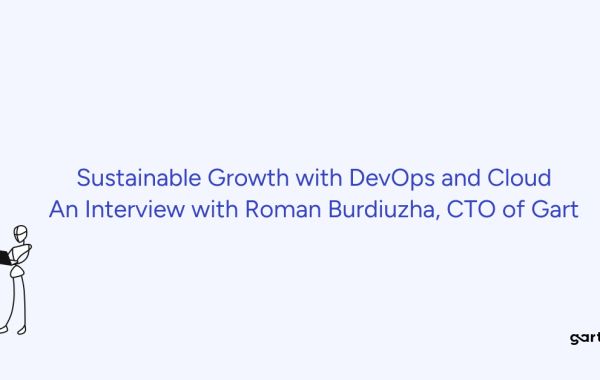Interviewer: Roman, with your extensive experience in DevOps and infrastructure architecture, how would you describe the importance of a solid DevOps foundation for businesses aiming for sustainable growth?
Roman: A solid DevOps foundation is crucial for businesses aiming for sustainable growth because it enables continuous integration and continuous delivery (CI/CD), which accelerates development cycles and improves product quality. By automating processes and fostering collaboration between development and operations teams, we reduce waste, optimize resource usage, and ensure that our systems are resilient and scalable. This not only drives efficiency but also aligns with sustainability goals by minimizing the environmental impact of IT operations.
Interviewer: As the CTO of Gart, how do you leverage cloud optimization to contribute to sustainability goals? Can you share some specific examples?
Roman: At Gart, we leverage cloud optimization to enhance both performance and sustainability. By utilizing tools like Kubernetes for container orchestration and Terraform for infrastructure as code, we ensure that resources are used efficiently, reducing unnecessary consumption. For example, we recently helped a client reduce their cloud costs by 30% while also cutting their carbon footprint by optimizing their workloads and leveraging auto-scaling features. This not only saved costs but also significantly reduced energy consumption.
Interviewer: You've specialized in Infrastructure as Code (IaC). How does IaC support sustainable IT practices, and what are the key benefits for organizations?
Roman: IaC supports sustainable IT practices by enabling automated, repeatable, and scalable infrastructure management. This reduces the need for physical hardware, minimizes errors, and ensures that resources are provisioned and deprovisioned efficiently. The key benefits for organizations include increased agility, reduced operational costs, and a smaller environmental footprint. By codifying infrastructure, we also enhance transparency and consistency, which are critical for maintaining sustainable practices.
Interviewer: At Gart, your mission is to help clients focus on business growth rather than infrastructure challenges. How do you balance this with the goal of driving sustainable IT transformations?
Roman: Balancing business growth with sustainable IT transformations involves integrating sustainability into the core of our solutions. We focus on creating efficient, scalable architectures that support long-term growth while minimizing environmental impact. By adopting green cloud strategies, optimizing resource utilization, and implementing best practices in DevOps and cloud management, we help clients achieve their growth objectives without compromising on sustainability. This holistic approach ensures that our clients can scale sustainably and remain competitive.
Interviewer: Can you discuss how cloud migration, when done right, can significantly reduce an organization’s environmental footprint? What role does Gart play in facilitating this process?
Roman: Cloud migration can significantly reduce an organization’s environmental footprint by shifting workloads to more energy-efficient, optimized cloud infrastructures. Major cloud providers like AWS, Azure, and Google Cloud are heavily invested in renewable energy and advanced data center technologies. At Gart, we facilitate this process by conducting thorough assessments, planning seamless migrations, and optimizing workloads for efficiency. By ensuring that migrations are well-planned and executed, we help clients reduce their carbon emissions and achieve their sustainability goals.
Interviewer: With over a decade of experience in various cloud platforms, where do you see the future of sustainable IT heading, and what innovations are you most excited about?
Roman: The future of sustainable IT is heading towards greater automation, AI-driven optimizations, and increased use of renewable energy sources. Innovations in AI and machine learning will enable smarter resource management, predictive maintenance, and more efficient data processing. I'm particularly excited about advancements in edge computing, which can reduce latency and energy consumption by processing data closer to where it's generated. Additionally, developments in green software engineering practices will further minimize the environmental impact of digital solutions.
Interviewer: Beyond your professional achievements, you’re committed to sustainable IT transformation. How does this personal commitment influence your work at Gart and your approach to client projects?
Roman: My personal commitment to sustainability deeply influences my work at Gart and my approach to client projects. I believe that technology should not only drive business growth but also contribute positively to our environment. This belief shapes our strategies, encouraging us to adopt and advocate for eco-friendly practices. When working with clients, we emphasize the importance of sustainability in their IT roadmap and provide solutions that align with their environmental goals. This commitment ensures that we deliver value not just in terms of performance and cost-efficiency, but also in terms of sustainability.








Nastya Zelenovska 46 C
https://gartsolutions.com/how-technology-can-drive-a-sustainable-future-for-business-devops-cloud-and-sustainable-it/